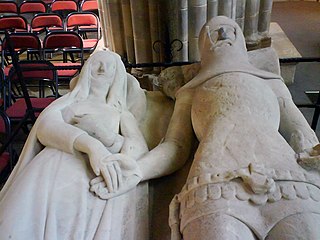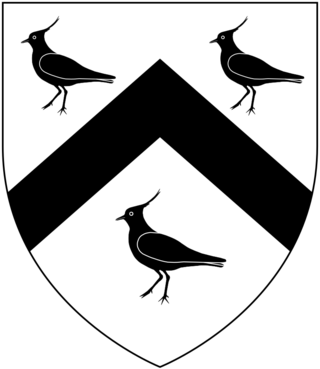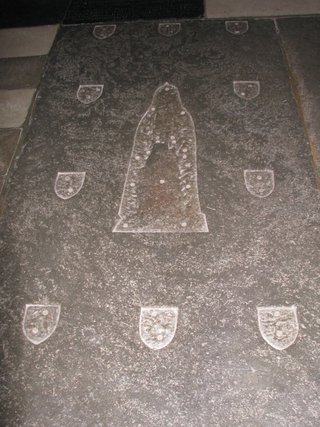
Nicholas Carew (died 1390), of Beddington in Surrey, was an English lawyer, landowner, courtier, administrator and politician who served as Keeper of the Privy Seal during the reign of King Edward III.

Nicholas Carew (died 1390), of Beddington in Surrey, was an English lawyer, landowner, courtier, administrator and politician who served as Keeper of the Privy Seal during the reign of King Edward III.
Traditional sources make him a son of Nicholas Carew, [2] [3] who married twice and died in 1308, but this is improbable and he was more likely a grandson. [4] [5]
Not being heir to any significant property, he likely trained as a lawyer, working for private clients and for the crown. By 1342 he had been granted the manor of Banstead in Surrey for life and to this he added holdings in Kent. Three major clients were Sir Richard Willoughby of Beddington, his daughter and heiress Lucy, and her first husband Sir Thomas Huscarle, an MP who was lord of the manor of Purley Magna in Berkshire and died by 1352. By 1356 Carew had married the widow, gaining control of her lands in Surrey and Berkshire, and made her manor of Beddington, which her father had bought in 1345, the family home. [5] [6]
In 1360 he was chosen to sit for Surrey in Parliament and he became a trusted member of the Royal Household. [5] In 1371 he was appointed Keeper of the Privy Seal, the first layman to hold the post, and remained in office until the king's death in 1377. [7] He was one of the group of courtiers around Edward III, including William, Lord Latimer, Lord John Neville, Sir Alan Buxhull, Richard Lyons, and the king's mistress Alice Perrers, who increasingly controlled access to and decisions emerging from the king as his health failed. Influential in the royal campaign in 1376 against William Wykeham, Bishop of Winchester, he was named as an executor and trustee of the king's will. [5]
After the king's death, he sat again for Surrey in the Parliament of October 1377. [5] Alice Perrers asked him to help refute the allegations against her but when she went on trial in December the court heard his view that it was she who induced the senile king to pardon Richard Lyons from his conviction for financial malpractice. [8]
Thereafter he seemed to have withdrawn from public life, dying on 17 August 1390. [5] In his will, made at Beddington on 13 October 1387 and proved at Croydon on 26 September 1390, he asked to be buried in the church of St Mary at Beddington next to his brother John, a priest. [9] Despite being a county member in Parliament and a senior member of government, he does not appear to have been knighted.
Sometime after 1352 he married Lucy, widow of Sir Thomas Huscarle and daughter and heiress of Sir Richard Willoughby of Beddington and his wife Elizabeth. [6] Children mentioned in his will were: [9]

Beddington is a suburban settlement in the London Borough of Sutton on the boundary with the London Borough of Croydon. Beddington is formed from a village of the same name which until early the 20th century still included land which became termed entirely as Wallington. The latter was in the 13th century shown on local maps as Hakebrug, and named after a bridge on the River Wandle. The locality has a landscaped wooded park at Beddington Park – also known as Carew Manor; and a nature reserve and sewage treatment works in the centre and to the north of its area respectively. The population of Beddington according to the 2011 census is 21,044.

Charles Brandon, 1st Duke of Suffolk was an English military leader and courtier. Through his third wife, Mary Tudor, he was brother-in-law to King Henry VIII.

Richard Fitzalan, 3rd Earl of Arundel, 8th Earl of Surrey was an English nobleman and medieval military leader and distinguished admiral. Arundel was one of the wealthiest nobles, and most loyal noble retainer of the chivalric code that governed the reign of Edward III of England.

The Cary family is an English aristocratic family with a branch in Ireland. The earliest known ancestor of the family is Sir Adam de Kari who was living in 1198. Sir John Cary purchased the Manor of Clovelly in the 14th century and established the family's status as members of the landed gentry. Various branches of the family were ennobled in the late 16th and early 17th centuries as Baron Hunsdon and Viscount Falkland.

Trerice is an historic manor in the parish of Newlyn East, near Newquay, Cornwall, United Kingdom. The surviving Tudor manor house known as Trerice House is located at Kestle Mill, three miles east of Newquay. The house with its surrounding garden has been owned by the National Trust since 1953 and is open to the public. The house is a Grade I listed building. The two stone lions on the front lawn are separately listed, Grade II. The garden features an orchard with old varieties of fruit trees.

Sir Nicholas Carew KG, of Beddington in Surrey, was an English courtier and diplomat during the reign of King Henry VIII. He was executed for his alleged part in the Exeter Conspiracy.

Elizabeth Carew was an English courtier and reputed mistress of King Henry VIII.

William Montagu, 2nd Baron Montagu, was an English peer, and an eminent soldier and courtier during the reigns of Edward I and Edward II. He played a significant role in the wars in Scotland and Wales, and was appointed steward of the household to Edward II. Perhaps as a result of the influence of his enemy, Thomas, 2nd Earl of Lancaster, Edward II sent him to Gascony as Seneschal in 1318. He died there in October of the following year.

Sir Richard Edgcumbe of Cotehele in the parish of Calstock in Cornwall, was an English courtier and Member of Parliament.

Sir Hugh I Courtenay, of Haccombe in Devon, was Sheriff of Devon for 1418/19 and was thrice elected knight of the shire for Devon in 1395, 1397 and 1421. He was a grandson of Hugh de Courtenay, 2nd/10th Earl of Devon (1303–1377), was the younger brother of Edward de Courtenay, 3rd/11th Earl of Devon (1357–1419), "The Blind Earl", and was the grandfather of Edward Courtenay, 1st Earl of Devon (d.1509), KG, created Earl of Devon in 1485 by King Henry VII. He was the link between the senior line of the Courtenay Earls of Devon made extinct following the Battle of Tewkesbury in 1471 and the post-Wars of the Roses creation of a new Earldom for his grandson made in 1485 by King Henry VII.
Sir George Harper, JP was an English politician. He was Member of Parliament for Kent.
Sir Nicholas Throckmorton or Carew was an English landowner and politician who sat in the House of Commons in two parliaments between 1601 and 1622.
The Manor of Clovelly is a historic manor in North Devon, England. Within the manor are situated the manor house known as Clovelly Court, the parish church of All Saints, and the famous picturesque fishing village of Clovelly. The parish church is unusually well-filled with well-preserved monuments to the lords of the manor, of the families of Cary, Hamlyn, Fane, Manners and Asquith. In 2015 the Rous family, direct descendants via several female lines of Zachary Hamlyn (1677–1759) the only purchaser of Clovelly since the 14th century, still own the estate or former manor, amounting to about 2,000 acres, including Clovelly Court and the advowson of the parish church, and the village of Clovelly, run as a major tourist attraction with annual paying visitor numbers of about 200,000.

Mohuns Ottery or Mohun's Ottery, is a house and historic manor in the parish of Luppitt, 1 mile south-east of the village of Luppitt and 4 miles north-east of Honiton in east Devon, England. From the 14th to the 16th centuries it was a seat of the Carew family. Several manorial court rolls survive at the Somerset Heritage Centre, Taunton, Somerset.

Nicholas Carew, Lord of Moulsford, was a baron of medieval England who took part in the Wars of Scottish Independence.

Walter FitzOther was a feudal baron of Eton in Buckinghamshire and was the first Constable of Windsor Castle in Berkshire, a principal royal residence of King William the Conqueror, and was a tenant-in-chief of that king of 21 manors in the counties of Berkshire, Buckinghamshire, Surrey, Hampshire and Middlesex, as well as holding a further 17 manors as a mesne tenant in the same counties.

John Twynyho of Cirencester, Bristol and Lechlade, all in Gloucestershire, was a lawyer and wealthy wool merchant who served as Recorder of Bristol, as a Member of Parliament for Bristol in Gloucestershire in 1472-5 and in 1484 and for the prestigious county seat Gloucestershire in 1476. In 1478 he was Attorney General to Lord Edward (the future King Edward V, eldest son and heir of King Edward IV.

The manor of Haccombe was a historic manor in the small parish of Haccombe, near the town of Newton Abbot, Devon, England. It was the seat of important branches of the Courtenay and Carew families.
Edward Guildford (c1390-1449) was an English landowner, administrator, and politician from the county of Kent who served three times as its MP and once as its Sheriff.

Lady Anne Boleyn was an English noblewoman, noted for being the great grandmother of Anne Boleyn and therefore the maternal great-great grandmother of Elizabeth I of England. She was the only child of Thomas Hoo, Baron Hoo and Hastings, and his first wife Elizabeth Wychingham. She married Sir Geoffrey Boleyn in c.1445.
{{citation}}: CS1 maint: location missing publisher (link)